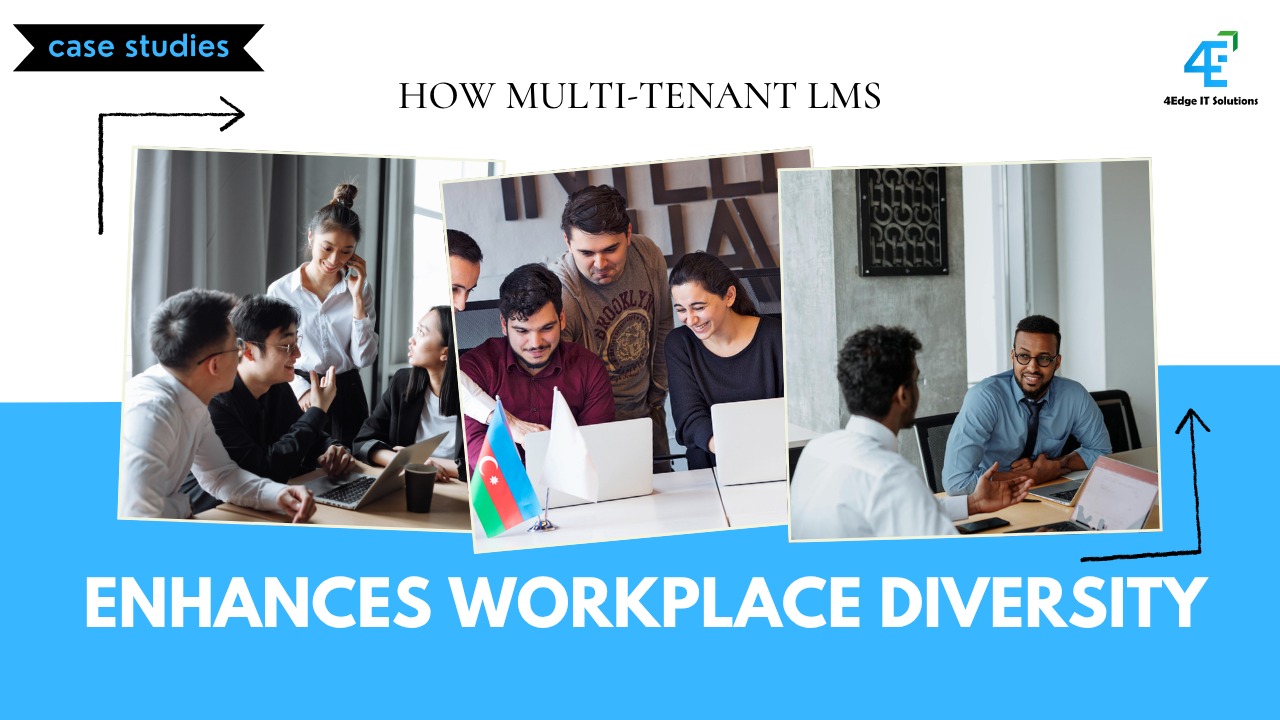How Multi-Tenant LMS Enhances Workplace Diversity | Case Study
This case study examines a transformative learning management solution designed for a client committed to fostering inclusive environments across a diverse, multi-tenant workforce.
By addressing complex training needs with a scalable, tailored approach, this initiative offers valuable insights for leaders seeking to enhance EDI programs in the U.S. market.
The Challenge: Scaling EDI Training Across a Multi-Tenant Landscape
The client faced a significant challenge: delivering consistent, impactful training on Prevention of Sexual Harassment (POSH), Diversity and Inclusion (D&I), and Employee Assistance Programs (EAP) to ~21,000 learners.

- Diverse Organizational Needs: Each tenant required training aligned with its unique culture, compliance requirements, and branding, making a one-size-fits-all approach ineffective.
- Scalability and Monitoring: Managing content delivery and tracking progress across thousands of users demanded a robust system to ensure accountability and engagement.
- Relevance and Retention:With 35% of U.S. employees reporting EDI training as irrelevant (SHRM, 2025), the solution needed to resonate with learners to drive meaningful change.
This complexity underscored the need for a learning platform capable of personalization, scalability, and comprehensive oversight in a distributed workforce.

The Solution: A Multi-Tenant Learning Management Approach
The deployed solution was a multi-tenant learning management system (LMS) designed to serve multiple client organizations under a single infrastructure, while providing a white-labeled experience. Key features included:
- White Labeling:Each organization’s learners accessed the platform as if it were their own, with customized branding and tailored content, fostering a sense of ownership and relevance.
- Content Mapping:The system hosted SCORM-based courses and MP4 video modules specific to POSH, D&I, and EAP, mapped to individual tenants to address their unique requirements.
- Centralized Server:All users logged into the same LMS server, ensuring efficient management, while content segregation maintained privacy and relevance across tenants.
- Custom Reporting: Advanced analytics provided multi-tenancy insights, tracking ~25,000 course enrollments and user progress to support data-driven decision-making.
This architecture enabled seamless delivery and monitoring, transforming a fragmented training process into a unified, scalable system.
Project Highlights and Implementation
The implementation showcased the platform’s versatility and effectiveness:
- Multi-Tenant Design: A single LMS instance supported ~21,000 users across real estate, banking, IT, and retail consulting, with white labeling ensuring a personalized experience for each tenant.
- Content Delivery: SCORM-based interactive modules and MP4 videos delivered engaging content, with offline sync options supporting learners in low-connectivity areas.
- Statistics: The platform recorded ~25,000 course enrollments, reflecting high engagement, with custom reports providing actionable insights into completion rates and compliance.
- Cross-Industry Reach: The solution adapted to the distinct needs of realtors navigating client diversity, bankers addressing regulatory pressures, and retail consultants managing frontline inclusivity.
This setup demonstrated the platform’s ability to cater to a broad spectrum of industries while maintaining operational efficiency.
Customer Benefits: Measurable Outcomes
The multi-tenant LMS delivered tangible results, aligning with industry benchmarks and client goals:
- Scalable Multi-Client Management:The platform efficiently handles diverse industries within a unified system, reducing administrative overhead, a critical advantage for HR teams.
- Streamlined Content Delivery:Seamless access to SCORM and video content achieved an 84% completion rate, even in remote settings ensuring consistent training reach.
- Enhanced Engagement: White-labeled environments boosted learner engagement.
- Data-Driven Insights: Custom reports enabled proactive adjustments, reducing compliance gaps and supporting an improvement in employee satisfaction related to inclusivity initiatives.
These outcomes highlight the solution’s role in fostering a culture of equality while maintaining operational continuity.
Implementation Strategies for Replication
Organizations can adopt similar approaches to enhance their EDI training programs and achieve scalable, impactful results:
- Customize Branding: Implement white labeling to align the training platform with your organization's identity. This personal touch can increase employee engagement and foster a sense of ownership over the learning experience.
- Utilize Interactive Content: Incorporate interactive content, such as SCORM-based modules and video-based learning, to ensure training is engaging and effective. This approach enhances learner participation and retention, making the content more impactful.
- Enable Offline Access: Make learning accessible to employees in remote or low-connectivity areas by offering offline access. Providing flexibility for learners to complete courses without relying on constant internet connectivity ensures inclusivity for all team members.
- Leverage Analytics: Utilize customized reports and real-time analytics to track learner progress, identify skill gaps, and make data-driven adjustments to training strategies. This helps improve compliance and ensures that your training efforts align with organizational goals.
- Promote Cross-Tenant Learning: Foster a culture of knowledge sharing across different tenants or departments. Encouraging the exchange of best practices helps enrich D&I programs and ensures that the training evolves with diverse perspectives, promoting continuous growth.
The Future of EDI Training
As of June 2025, the U.S. workplace is evolving, with hybrid work projected to grow 20% annually (IDC, 2025). Multi-tenant LMSs are advancing with AI-driven personalization and immersive tools like VR for sensitivity training, shifting focus from compliance to cultural transformation.
Take Action: Elevate Your EDI Strategy
This case study demonstrates how a multi-tenant learning solution can empower 21,000+ learners to champion workplace equality without operational disruption. The insights gained—scalability, engagement, and data-driven refinement—offer a blueprint for your organization.
What EDI or training challenge are you tackling?